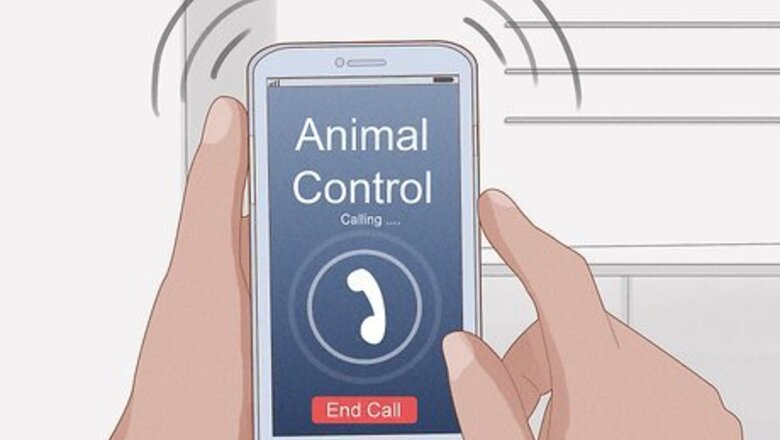
views
- Call animal control to handle the situation if you think the snake could be venomous.
- Remove non-venomous snakes from indoor areas by sweeping them into a trash can or capturing them in an indoor trap.
- Leave snakes alone if you find them outdoors.
- Keep snakes from hanging around your yard by trimming vegetation in your yard, sealing entry points, and using repellant.
Removing Snakes from Indoors

Call animal control if you fear the snake may be venomous. If you're uncomfortable handling a snake, even if you don't believe it to be venomous, there's no reason you should deal with it yourself. Call animal control to trap it and take it away. Snakes with venomous bites should always be handled by professionals, such as animal control employees or a wildlife trapper. Try to enclose the snake in one room. If you see it in the laundry room, for example, shut the door and wedge a towel underneath it to prevent the snake from escaping. Keep children and pets away from the area until animal control has captured the snake.
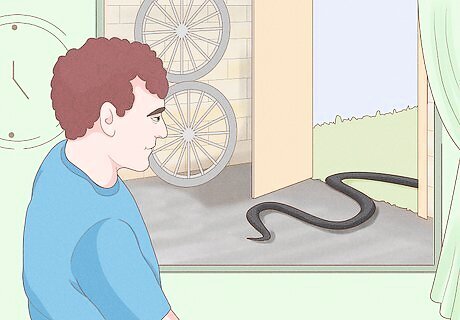
Leave the snake alone and let it find a way outside. Most snakes will leave your house on their own if given time and opportunity. If you find a snake in your garage or in a room leading to the outside, shut the inside doors and open the door leading outside so the snake can slither out. The snake should leave fairly quickly. This is a simpler and more reliable method than a more aggressive hands-on approach, which may frighten the snake and cause it to hide in a hard-to-reach location in your home.
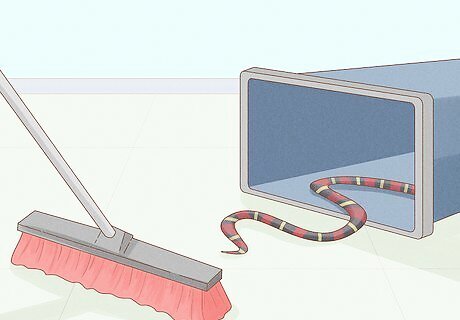
Brush a non-venomous snake into a large trash can. If you feel comfortable taking care of the snake on your own, try this common removal method: first, set a large trash can on its side in the same room as the snake. Then use a push-broom to shoo the snake into the trash can. Once the snake is in the trash can, tip the can upright and place a lid firmly on top. Once the snake is securely inside of the trashcan, take the snake to the woods or another area away from your house. Set the can on its side, gently remove the lid, and give the snake time to slither out. Ask a friend, family member, or neighbour to help if you can. An extra pair of hands will make the process go faster and more smoothly.

Catch the snake with an indoor trap. If you suspect there may be a snake in your attic, garage, basement or elsewhere in your house, lay out traps along the walls in these areas. Snakes will slither over or into the traps and get stuck. You—or animal control—can then safely remove the trapped snake and place it outside. If you catch a non-venomous snake, place the trap in a bucket and take it outside or to an area where you'd like to release it. Pour vegetable oil over the snake to loosen it from the trap and allow it to crawl away. Check the traps every day to see if you've caught a snake. If you wait too long, the snake will die of starvation.
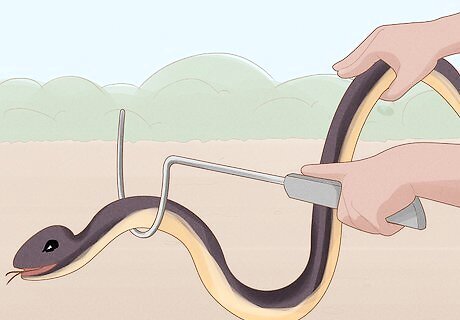
Pick up the snake and remove it if you're certain it's non-venomous. Put on thick yard gloves for extra protection. Slide a stick under the snake's head and pick up the back half of its body with your other hand. You can also pick up the snake by grasping it firmly behind the head. Make sure the snake isn't venomous before you pick it up. If you have any doubts, don't touch it. Remember that the closer you get to the snake, the more likely you are to get hurt.
Removing Snakes Outdoors

Let the snake leave on its own. If you're dealing with a non-venomous snake, the simplest removal method is to let the snake leave your property on its own. Outdoor snakes pose no serious problem and will wander off in their own time. However, if you have children or pets, keep them away from the snake. Even non-venomous snakes can have painful bites. If you frequently notice snakes near your house, your concern should be preventative maintenance rather than individual snake removal.
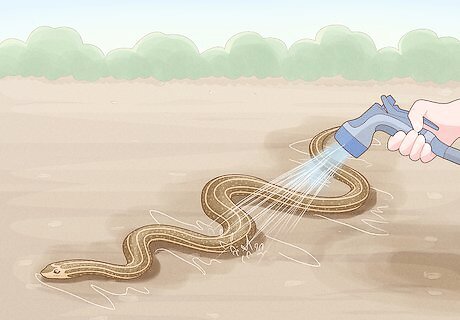
Spray the snake with water from a hose. If you see a non-venomous snake hanging out near your house and you'd like it to go somewhere else, sometimes all it needs is a little nudge to be on its way. Use a garden hose to lightly spray the snake until it moves away from your house and out of your yard. Garter snakes and other snakes that you know not to be dangerous are fine candidates for this removal method.

Remove a snake from the water with a pool skimmer. If you find a snake in your pool, you can safely lift it out using a pool skimmer or other kind of meshed net. Small, non-venomous snakes can also be plucked from the patio or grass with a pool skimmer. Try not to grip them too tightly, so you don't damage their ribs. Take the snake to the back of your yard or to a nearby wooded area and set them free.
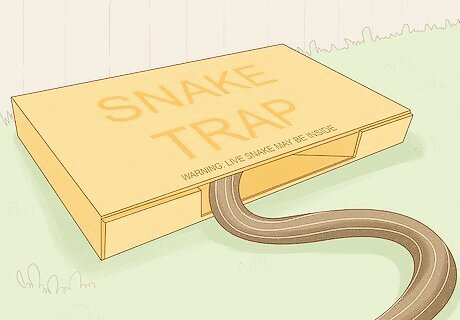
Set outdoor snake traps. Outdoor snake traps are usually plastic boxes baited with a substance or aroma that lures snakes inside. Once snakes enter the trap, the shape of the box prevents them from getting out. Set them around your property in areas where you've seen snakes spending time. When you trap a snake, drive it to a wooded area and set it free. Avoid using poisonous snake traps on snakes that have entered your yard. Snakes are an important part of the ecosystem and should be safely removed, rather than killed.
Preventing Re-Infestation
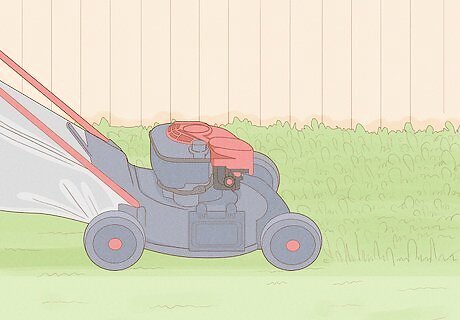
Trim backyard vegetation. Snakes' typical habitats contain tall grass and bushes, so regularly cutting your grass and trimming bushes and shrubs will make your yard less enticing for snakes. Mow your lawn and remove any downed tree trunks, hollow stumps, or other places where snakes could live. Take these measures to make sure your yard isn't full of potential snake dens: Store lumber and woodpiles at least 2 feet (0.6 m) off the ground, and keep compost and mulch piles away from your house. Consider removing bushes and other tall vegetation that seems to be a regular habitat for snakes.
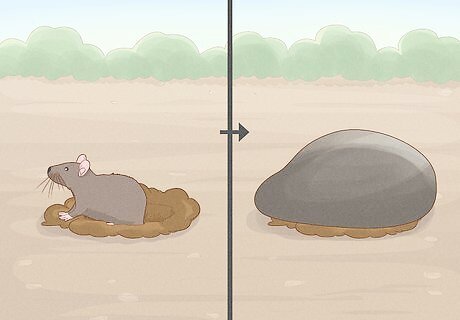
Remove snakes' food sources. Snakes eat mice, crickets, and other insects. If you take measures to keep the populations of these creatures low, snakes will look elsewhere for food. Use soil and rocks to block up any rodent holes in your backyard. Keep your yard free of birdseed, berries, nuts that have fallen from trees, and stray bits of waste from the compost pile. These are all food sources for mice and insects. Consider removing mice and insects from your property by setting traps or using other removal methods. See How to Get Rid of Mice and How to Get Rid of Crickets for more ideas.

Seal your house. Prevent snakes from entering your home by checking its foundation for cracks and holes. Seal any that you find with caulk or expanding foam. Make sure that your doors and windows are sealed, too. Place screens on your chimney, vents, and other places where snakes might be able to get in. The grid of the screens should not have openings larger than ¼ inch (0.6 cm), in order to effectively block all snakes.
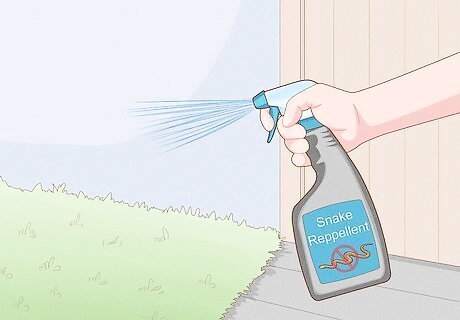
Apply snake repellent around your house and yard. Snake repellents are typically sold as either a liquid, which you can spray on the external walls of your house or a powder, which you can sprinkle throughout your yard. These repellents are environmentally friendly and will not harm your pets or lawn. Various types of commercial snake repellents should be sold at your local hardware store or garden center. You can also find snake repellents online through major retailers.
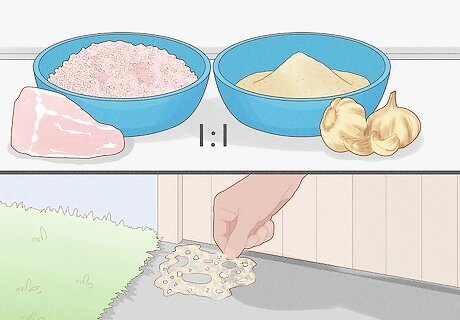
Make your own repellent for a quick, DIY solution. Mix equal amounts of rock salt and crushed garlic and sprinkle it around the entrances to your home, garden, or anywhere else you don't want snakes to be. If you have a major infestation, make a strong homemade solution out of equal parts sulfur and moth crystal.




















Comments
0 comment